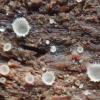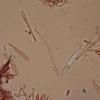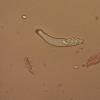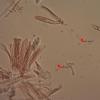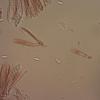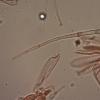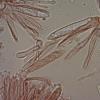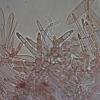
15-01-2026 15:55
 Lothar Krieglsteiner
Lothar Krieglsteiner
this one is especially interesting for me because

16-01-2026 00:45
Ethan CrensonHi all, On decorticated hardwood from a New York

18-01-2026 12:24
Hello.An anamorph located on the surface of a thin

17-01-2026 19:35
Arnold BüschlenHallo, ich suche zu Cosmospora aurantiicola Lite

08-12-2025 17:37
 Lothar Krieglsteiner
Lothar Krieglsteiner
20.6.25, on branch of Abies infected and thickened

10-01-2026 20:00
Tom SchrierHi all,We found picnidia on Protoparmeliopsis mur

13-01-2026 07:28
 Danny Newman
Danny Newman
Chlorociboria glauca on indet. decorticate logThe
Hyaloscypha leuconica?
Marc Detollenaere,
18-03-2023 08:31
 Good morning Forum,
Good morning Forum,Could anyone help me to identify this Hyaloscypha? It was growing on a fallen trunk of Quercus robur .Hairs were tapering, not bearing resine in water mounts, 70-80µ long.Asci were MLZ+ and measured 44x7µ.No croziers were found. The spores measured 6.6-7.5x2.4-2.6µ and contained a few small drops. H leuconica could match.
Kosonen Timo,
18-03-2023 09:00

Re : Hyaloscypha leuconica?
Hi Marc,
I think you have the good ol' Olla transiens here: spores <10 um, with two small +- polar (near each end) guttulae, multiseptate (or more than one anyway) hairs with dextrinoid apex (it's very modest -small in the long hairs, but observe the small hairs with huge glassy parts.
The ascus base is a bit of a mystery to me. I think there are records of "Olla transiens" with both with and without crozier. The morphological interpretation (if a crozier exists) is sometimes difficult especially if the crozier is inconspicious, but. yeah. maybe someone else can shed some light here. I know Zotto has folders from both crozier+ and crozier- Olla millepunctata for example. I have some sequences of Olla transiens both with and without but there's no indication of, say, with-crozier samples grouping together.
The "wet - greasy" looks of the hairs in the macro is something I connect with Olla transiens also. Hyaloscyphas have often a slightly more elegant looks, if you may.
Timo
I think you have the good ol' Olla transiens here: spores <10 um, with two small +- polar (near each end) guttulae, multiseptate (or more than one anyway) hairs with dextrinoid apex (it's very modest -small in the long hairs, but observe the small hairs with huge glassy parts.
The ascus base is a bit of a mystery to me. I think there are records of "Olla transiens" with both with and without crozier. The morphological interpretation (if a crozier exists) is sometimes difficult especially if the crozier is inconspicious, but. yeah. maybe someone else can shed some light here. I know Zotto has folders from both crozier+ and crozier- Olla millepunctata for example. I have some sequences of Olla transiens both with and without but there's no indication of, say, with-crozier samples grouping together.
The "wet - greasy" looks of the hairs in the macro is something I connect with Olla transiens also. Hyaloscyphas have often a slightly more elegant looks, if you may.
Timo
Hans-Otto Baral,
18-03-2023 09:40

Re : Hyaloscypha leuconica?
Difficult to say with the ascus base. The photos are often unfortunate, maybe too small, but I tend to be sure that croziers are absent.
Another option would be Psilocistella quercina, but there the asci have clear croziers.
Did you test the ascus reaction also with IKI? O. transiens tends to be hemiamyloid, i.e. turning dirty reddish at higher iodine concentration.
Olla transiens had never true croziers in the many finds I saw but often a basal protuberance which can be mistaken for a crozier. Usually the hairs have glassy caps but these are sometimes partly and rarely completely missing. The easiest would be if you find some glassy caps.
Ingo Wagner,
18-03-2023 16:29

Re : Hyaloscypha leuconica?
Hello!
Micropicture 1 and 4 show the transiens-hairs and the last picture show "croziers = negative". In my opinion it is clear Olla transiens.
Greetings
Ingo
Micropicture 1 and 4 show the transiens-hairs and the last picture show "croziers = negative". In my opinion it is clear Olla transiens.
Greetings
Ingo
Hans-Otto Baral,
18-03-2023 17:02

Re : Hyaloscypha leuconica?
Indeed Ingo, I overlooked, perhaps because most of these glassy tips (I now count 5-6) are unfortunately unsharp on these pics.
Marc Detollenaere,
18-03-2023 17:04
Hans-Otto Baral,
18-03-2023 17:14

Re : Hyaloscypha leuconica?
yes, very clear and typical. So the reaction was blue? Is the iodine strong enough? But the reaction is only very indistictly red in this species as I remember.


